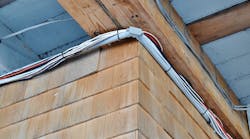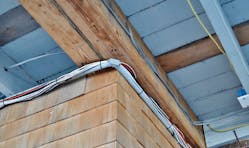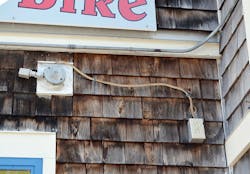How well do you know the Code? Think you can spot violations the original installer either ignored or couldn’t identify? Here’s your chance to moonlight as an electrical inspector and second-guess someone else’s work from the safety of your living room or office. Can you identify the specific Code violation(s) in this photo? Note: Submitted comments must include specific references from the 2017 NEC.
Hint: Hitching a ride on a raceway
December Winner
I only received one winning submission for December’s contest. Perhaps the rest of you were too busy enjoying the holiday season to send in your comments. In any case, our sole winner this month was Robert P. Ducote, P.E., senior engineer for EDG, Inc., of Metairie, La. He correctly identified several Code violations in the photo.
I spotted this installation on the outside of a gift store while on a weekend trip. This particular store offered up several Code violations that I will happily share with you in the coming months. Using NM cable in this
outdoor wet location is a violation of Sec. 334.12(B)(4). NM cable can’t be used in damp locations either. Damp locations would include partially protected areas under canopies, roofed open porches, and other locations subject to moderate moisture, such as some basements and cold storage warehouses. NM cable is only permitted for use in normally dry locations. The receptacle and its cover are another concern. In wet locations, 15A and 20A, 125V and 250V rated receptacles must be installed in an enclosure that is weatherproof (whether or not anything is plugged into it), as required by Sec. 406.9(B)(1). These receptacles must also be listed as being a weather-resistant (WR) type.






